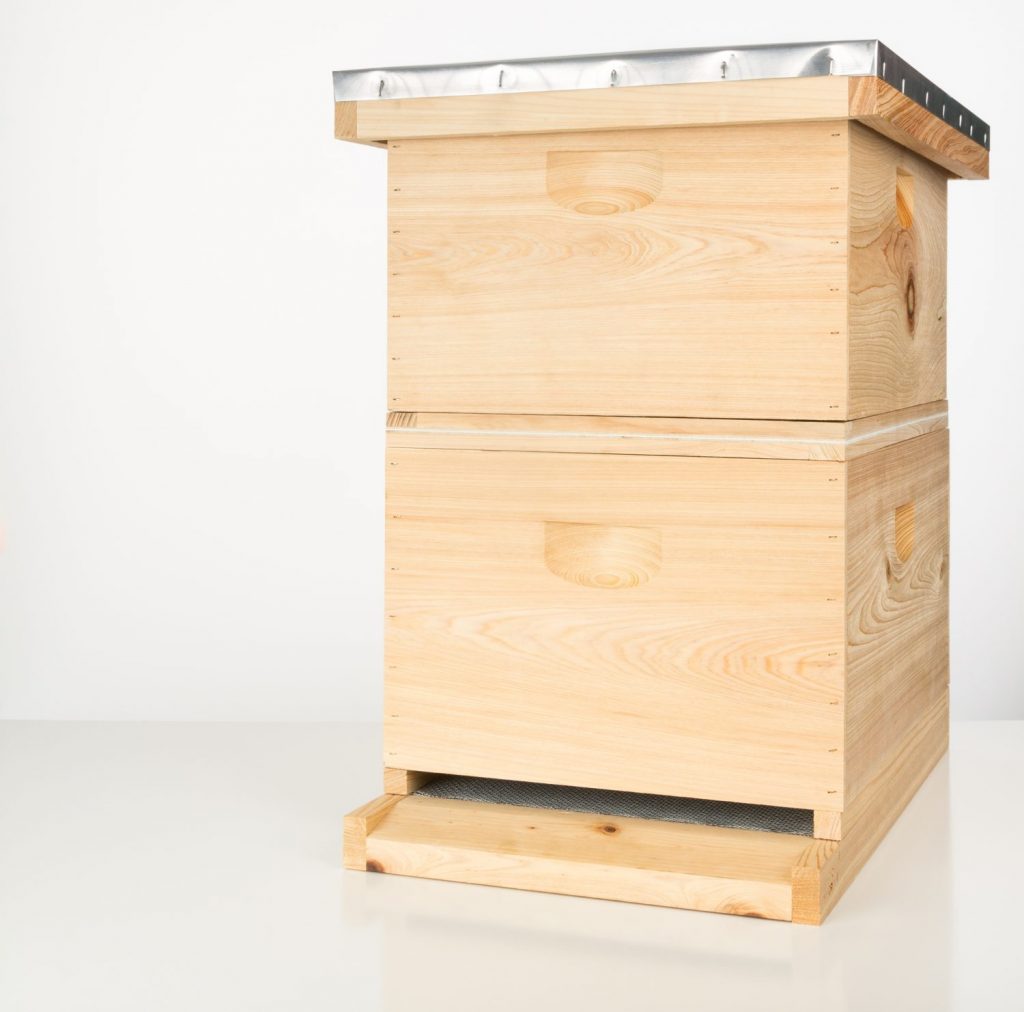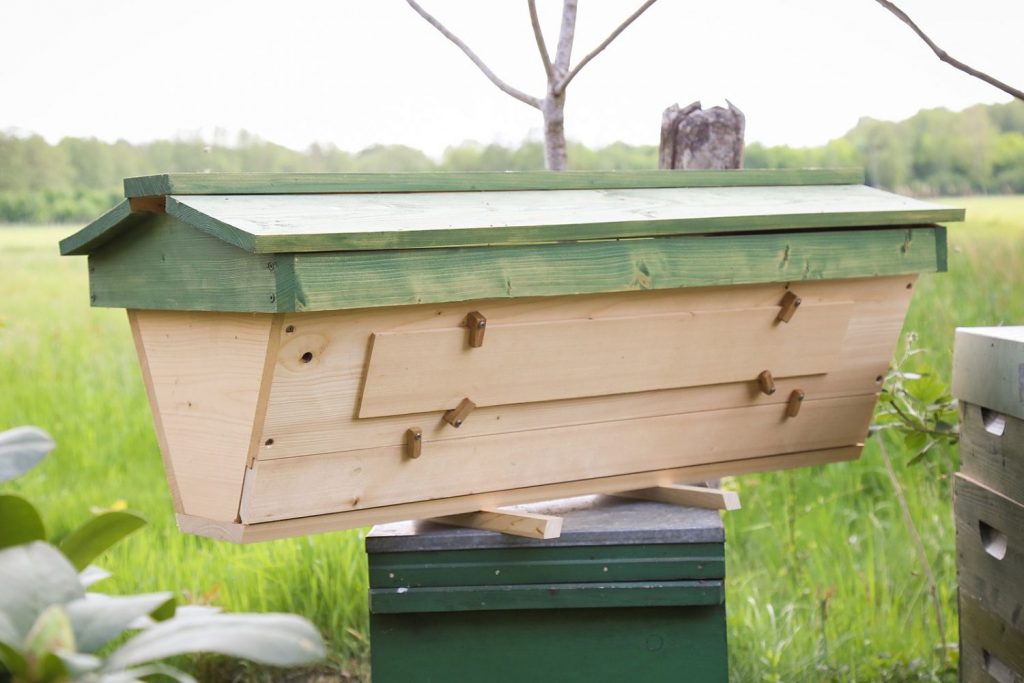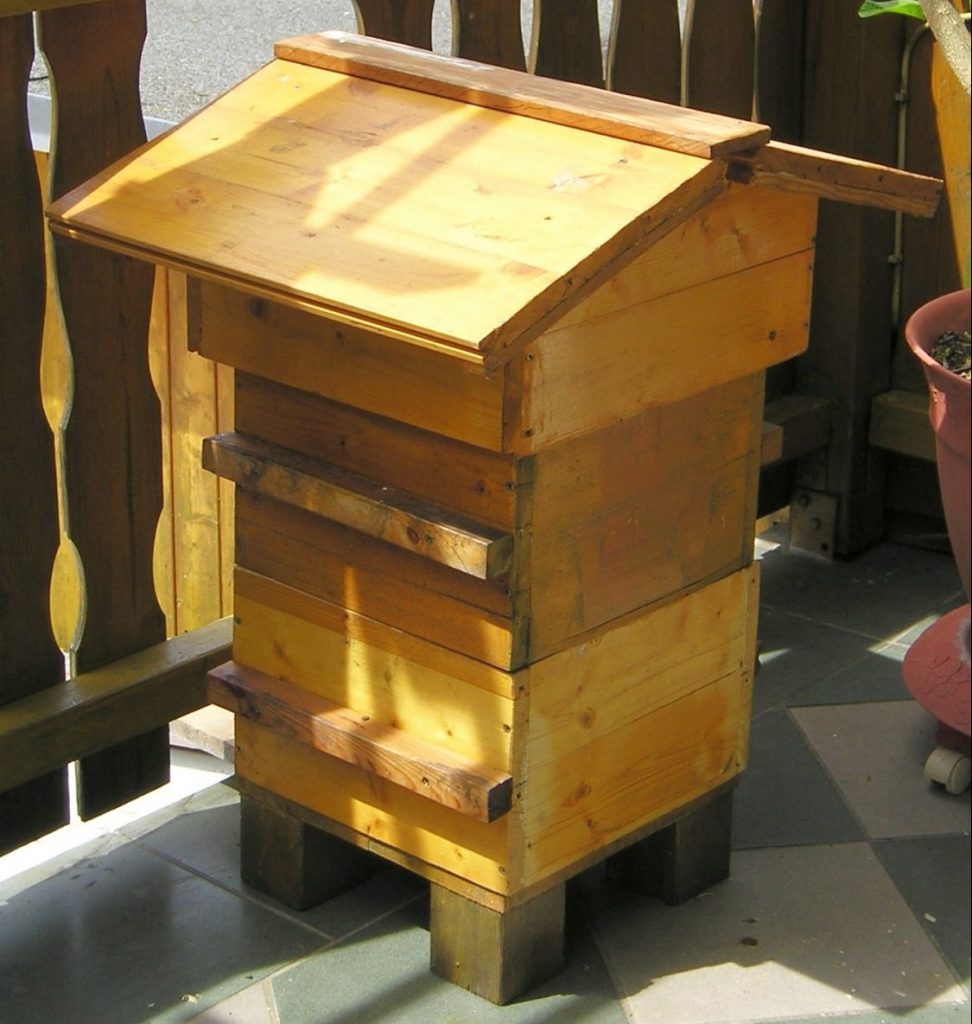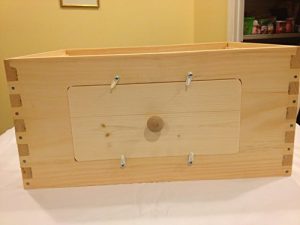If you purchase an independently reviewed item through our site, we earn an affiliate commission. Read our affiliate disclosure.
In this article we will be looking at a beehive comparison of the Langstroth, Top bar and Warré beehives. We will look at the design of the beehives themselves, their upsides, downsides and a brief history of each.
Beekeeping has seen a lot of advances over the years. One component of the practice cannot be ignored is the type of beehive that is used. There are various types of beehives that are common today. They all came about from research by various beekeepers and inventors who studied bees and then developed the beehives that house them. In modern beekeeping, three beehive types stand out and lead the pack. These are the Langstroth, Top bar and Warré beehives. Their popularity and appropriateness in beekeeping varies by the individual beekeeper and the region where beekeeping is being practiced.
It must also be acknowledged that beekeeping is evolving. In past years, beekeeping was largely oriented towards harvesting honey, beeswax and other hive products. Today, beekeeping is increasingly taking on a conservationist angle due to pressure on the survival of honey bees. A number of factors have led to the population of honey bees and other wild bees declining – with alarming rapidity in some places. The beehives that beekeepers use today are therefore best chosen with their individual motives at the very top of the priority list.
Factors of Beehive Comparison and Selection
Beekeeping for conservation
Keeping bees for conservation purposes makes profits take a backseat in priority. Swarming is encouraged in conservation beekeeping while it is frowned upon in profit-oriented beekeeping. Conservation beekeepers may also not be very tolerant to beekeeping that is labor, resource and time intensive. For them, a beehive that allows the most hands-free beekeeping makes the most sense.
Budgetary needs
Every beehive type has its cost implications. Beekeepers on a tight budget will want to go for the lower-cost beehives so they can at least start beekeeping. This is a major factor for beginner beekeepers and those who are not in beekeeping for profits.
Honey production
Beekeepers that are aiming at honey production want the beehive type that will give them the highest yields of good quality honey. Indeed, honey is one of the most visible beehive products. It is only natural that beekeepers want to have some honey even if they are not aiming to sell it off for profit-making purposes. Honey is used as a sweetener and for medicinal purposes.
Beeswax production
Beeswax is a second major beehive product after honey. The total yield of beeswax that can be harvested from a beehive plays a major role in beekeepers deciding what type of beehive they will go for. Beeswax has many uses in addition to making candles. It has found applications in alternative medicine and cosmetics which has made it a very valuable and sought-after beehive product.
Ease of management
Beekeeping requires the beekeeper to interact with bees and the beehive. If it is not easy to work with a beehive, the beekeeper will not carry out hive management activities well, or on time. The weight that the beekeeper deals with and ease of harvesting of beehive products also come in here.
Expandability
Beekeepers may start small and grow their apiaries with time. Beehives that offer expandability are great for such beekeepers. Additionally, newly installed honey bee colonies that are small need space to grow into if they are not going to split and swarm. The objectives and preferences of beekeepers may change over time, and it is best if the beehive can be adapted to suit the changing preferences and objectives too.
Wintering / regional considerations
Cold weather leads to very high mortality rates on honey bees. Successful survival through winter and cold seasons is important if the beekeeper hopes to have a useful honey bee colony after the cold season has passed. Vertically expandable beehives give the best survival rates for honeybee colonies.
Organic beekeeping / accumulation of chemicals
The demand for organically produced products cannot be ignored by beekeepers. It is in their best interests to go to the market with products that customers want and are likely to buy. As a result, the quest for reduced presence of chemicals in beehive products has pushed more beekeepers to explore organic beekeeping. They are also finding ways to avoid excessive accumulation of chemicals in beehives and beehive products.
It is important to note that even when beekeepers do not use chemicals in their beekeeping, foraging honey bees may get into contact with chemicals applied on farmland and bring them into the beehive.
Availability of equipment, accessories and spares
No beekeeper wants to be stuck with a beehive for which they cannot find spare parts, accessories and equipment to work the hive.
With all that said, now let’s now get into discussing the beehive comparisons.
The Langstroth Hive

In any considerable sample of beehives you take, Langstroth hives are bound to feature prominently. A Langstroth beehive is synonymous with beekeeping in modern times. Most of the beehives you have seen in your lifetime are likely to be Langstroth. The popularity of this beehive is largely due to the ease of management, high beehive products yields and their vertical expandability. Langstroth beehives come in two popular configurations: 8-frame and 10-frame.
A Brief History of the Langstroth Hive
An American reverend, L.L. Langstroth, is credited with the invention of this beehive design. He was an apiarist and teacher in addition to his clergyman duties. Langstroth published a lot of works about beekeeping and is often referred to as the father of modern beekeeping. Langstroth beehives are built to mimic the natural settings in which honey bees live, with a few modifications. A Langstroth beehive was the first beehive to use the concept of ‘bee space’ which was discovered by L.L. Langstroth.
As noted, Langstroth beehives have high yields of beehive products. They also put to use beehive frames onto which honey bees draw comb. The beekeeper that uses Langstroth beehives can decide if they want more honey than beeswax from, as well as other possible beehive products. It is possible to harvest honey from Langstroth beehives, without damaging or destroying honeycomb – thus making it possible to maximize honey production using this beehive.
Langstroth Beehives are Ubiquitous
A lot of beekeeping equipment, accessories and research are centered around the Langstroth beehive. It is one beehive for which you are sure to find anything you want, including information about its use, maintenance and how to build it. One of its downsides as we will later see is that it has many components that must be precisely built and used. Honey bee survival in a Langstroth beehive is very high, so surely it has a lot of things right about it.
Setup of Langstroth Beehives
A Langstroth beehive sits on a stand or legs. It has a bottom board with the entrance through which bees come and go. A landing board may be used or not. Above the bottom board are brood boxes. On top of the brood boxes are super boxes for honey storage.
To keep the beehive dry and protected from the elements, an inner cover and top cover are used on the beehive. The uppermost top cover can be telescoping or built in various styles to drain water away from the hive. Between the brood boxes and the super boxes, a queen excluder may be used in Langstroth beehives to prevent brood from being reared in the super boxes.
Hive Boxes and Frames
Langstroth beehive boxes are of 3 standard sizes: deep, medium and shallow. Deep boxes are largely used for brood rearing. Medium and shallow boxes are used for honey storage as super boxes. Lately, Langstroth beehives have seen a new type of beehive frames used in them. Flow frames are a relatively new technology that allows beekeepers to harvest honey without having to remove the beehive frames. They promise clean honey and high honey yields since honeycomb is not destroyed.
Management of Langstroth Beehives
Managing a Langstroth beehive is done by the frame. Hive inspections are a common and frequent activity. Many maintenance activities also need to be carried out in accordance with the targets of the beekeeper and the beehive products they want to harvest from the beehive. Langstroth beehives can be expanded vertically by adding more boxes to the top or bottom, depending on whether the beekeeper wants more brood rearing space, or honey storage space in the beehive.
Pros
- Easy to manage and inspect while giving high yields of beehive products.
- Has a lot of literature about it, as well as easy availability of tools, equipment and accessories at low cost.
Cons
- Has many parts and therefore many places where breakdowns and errors can be found in a beehive
- Hive inspection requires opening up the entire hive which is too intrusive into the space of honey bees.
The Top Bar Hive

The second beehive type we will look at is the top bar hive. It is the oldest beehive in beekeeping, although it has undergone a number of changes and modifications that have resulted in its present form. The top bar hive in use today is a hive cavity with top bars or wedges laid across the top of the cavity. It is rectangular and horizontal. Top bar hives are not very expandable.
A Brief History of the Top Bar Hive
The invention of the modern top bar hive is credited to African researchers in Kenya and Tanzania. The Kenya Top Bar Hive (KTBH) is the most popular of all top bar hive designs. It was developed as a result of Canadian university research conducted in Kenya, where the Canadian researchers worked with Kenyan researchers. Top bar beehives are not bulky, and rarely present challenges in management since beekeepers do not have to deal with heavy weight.
Setup of Top Bar Hives
Top bar hives are single-story and horizontal. They make use of a simple hive cavity that includes the brood rearing area and honey storage. Top bar hives mimic log hives to a very high degree. Honey is found stored in the comb that is furthest from the entrance.
There are no beehive frames used on top bar hives. In the place of frames, they instead use top bars with a wedge shape. Honey bees draw comb under, and attached to the top bars. A roof covers the bars and hive cavity to keep it dry. Entrances to a top bar hive are small round holes drilled at the ends of the hive or the sides. The entrances always have to be at the lower sections of the beehive.
In their original design, top bar hives do not rest on stands in most cases. They are suspended using wires, although some beekeepers prefer to build stands that elevate the beehives to waist level for comfort while working on the hive. Suspension using wires or other suitable material is the best protection for top bar hives against predators, and pests that may prey on honey bees and hive resources such as ants.
Management of Top Bar Hives
Managing a top bar hive is a breeze for beekeepers of any experience level. The beehive is at a height that is comfortable for the beekeeper to access and assess while standing. There are no boxes or heavy objects to lift when working with a top bar hive. Management and inspection is done by lifting out one top bar at a time. This reduces the total area exposed to the elements at a time.
Harvesting honey and wax from this type of beehive is also easy, since you can use a queen excluder with it. Brood is reared at the front section near top bar hive entrances, so honey is found at the rear. The major shortcoming of top bar hives is that it is not expandable, so the size of the honeybee colony is limited to a certain maximum beyond which it cannot grow. The yields of beehive products per beehive are also limited because of this shortcoming.
Pros
- Weight management is not a problem with this beehive.
- When suspended using wires, this beehive is very safe from honeybee predators.
Cons
- Not very suitable for wintering bees.
- Due to space constraints, swarming is likely to occur frequently as the colony outgrows the hive.
- Also due to space constraints, yields of beehive products can be low.
The Warré Hive

This beehive comparison would not be complete without talking about the Warré hive. This is a rather square beehive whose design mirrors the natural hollow tree hives quite well. In the wild, honey bees seek out spaces that closely resemble the horizontal cross-section of a Warré hive. Similarly, bees build honeycomb from the top downwards. As found in Warré hives, honey bees rear brood at the top of drawn comb, and gradually move the brood to the lower sections of the beehive or comb as more comb gets built. Eventually, brood is at the bottom of the beehive, with the upper sections of the beehive and honeycomb left to honey storage. In winter, the bees gradually move upwards in the beehive, eating honey as they go.
A Brief History of the Warré Hive
The Warré hive was invented and popularized by a French beekeeping researcher named Émile Warré. He was a monk who studied many beehive types of his time and settled on a new design he aptly called the Warré hive. This design of the beehive has a lot of emphasis on easy management of the beehive by largely allowing honey bees to go about their activities with minimal intrusions and interruptions.
True to its rather religious origins, the Warré hive is famed for its beeswax production capabilities. It is not far-fetched speculation in beekeeping circles that Warré hives came about to help provide large amounts of beeswax needed for religious purposes at the time. The major need for beeswax in religion included candles and seals for official communication.
In modern times, a Warré hive is not entirely rare to see, but it is still not a common sight. It can be used in any region on the globe with no major problems or challenges to honey bee survival. This type of beehive is likely to see a surge in popularity as more people embrace beekeeping for conservation purposes. It is not likely to find any fans in the beekeeping-for-honey operations.
Setup of Warré Hives
Boxes of similar size make up a Warré beehive. Only one box at the top of the beehive is of slightly different dimensions from the other boxes in the stack. This uppermost box holds material to absorb moisture and help control beehive humidity. It helps prevent condensation that can be very deleterious to honey bees in a beehive. A Warré hive rests on a stand or legs. It may have a landing board. It is not common to find queen excluders in Warré hives, but they can be included at the pleasure of the beekeeper. Warré hives feature top bars or wedges on which bees draw comb.
Management of Warré Hives
Management of a Warré beehive is quite hands-free. The honey bee colony is mostly left to its devices with very few hive inspections done. Beehive boxes are added only to the bottom of the hive for bees to draw comb and raise brood. The boxes at the top of the hive containing honey are removed at the end of honey-flow season. This aspect of Warré beehive management leads to very low levels of accumulated chemicals in beeswax, honey and other hive products. It also gives the Warré beehive its high capability to yield large amounts of beeswax.
Pros
- Gives high yields of beeswax due to removal of upper boxes every year.
- Mimics natural spaces that bees use for their hives.
Cons
- Does not give high yields of honey per beehive per year.
- Can be difficult to work with – especially when you have to add boxes at the bottom of the hive.
Beehive Comparison – Which one Wins, and Where?
Langstroth
- The Langstroth beehive wins when it comes to harvesting a variety of beehive products from the beehive. These include pollen, royal jelly, and beeswax.
- Langstroth beehives are also the best beehives to go for when your beekeeping is aimed at getting high yields of honey per beehive per year.
- You can keep large colonies in Langstroth beehives for splitting when you want to make money selling honey bees or for repopulating your other beehives.
- You are also very sure that your beekeeping with Langstroth beehives will be a breeze due to abundance of information about the beehive, equipment and accessories from many manufacturers.
Top Bar
- Top bar hives also win in conservation beekeeping, but only if the beekeeper is practicing in a region where there are no cold winters.
- Elderly beekeepers are also very well suited by top bar hives since there are no heavy weights to lift with this beehive.
- A top bar hive is also great for housing a reserve honey bee colony that you can use to repopulate other beehives in your apiary.
Warré
- This type of beehive is the recommended when you are a conservationist beekeeper, primarily interested in supporting a honey bee colony’s existence. You can let swarming occur periodically to contribute to wild populations of bees.
- A Warré hive is also a safe choice for beekeepers that are targeting beeswax as their major beehive product.
The Advancement of Hive Observation
As we mentioned earlier, beekeeping has evolved over the centuries, and is still evolving. It has been noted that beekeepers want to have a peek inside beehives – and this is encouraged since observation of how well bees are doing is part of hive management. As a result, viewing ports are finding their way into beehives with increasing frequency. These viewing ports are made of glass or other clear transparent material. They are usually made in the sides of beehives and allow the beekeeper to look inside the beehive without opening it up.
All the three types of beehives we have looked at have found ways to incorporate viewing ports. While this common addition cannot be said to be a direct advantage or disadvantage for any type of beehive, the viewing ports on some types of beehives allow you to see more of the beehive than others. If a viewing port is priority for you, consider having one in the beehive type that allows you to see a wide cross-section of the beehive and what is going on inside.
Conclusion
Beekeeping has come a long way since humans started housing bees in specially prepared spaces. The beehives we use today and going forward must always be dictated by the needs of beekeepers, and the best interests for the well-being of honey bees. A balance between profit and suitable dwellings must be struck for best results in beekeeping.
The three beehives analyzed in this article each have their advantages over each other, and similarities that have made them survive as the top beehives in modern times. This Langstroth, Top bar and Warré beehive comparison is a great resource when you are going into beekeeping for whatever reason is in your mind. Use it to decide the beehive you will adopt so you can easily achieve your beekeeping goals.
Among Langstroth, Top Bar and Warré beehives, which is your preferred type? Leave a comment below and let us know.
 BeeKeepClub Resources and Guides for Beekeepers
BeeKeepClub Resources and Guides for Beekeepers


I live in an alpine climate, but am going to try housing a top bar beehive inside my super insulated, double glazed potting shed. A panel will open up on outside north facing wall (southern hemisphere), so all operation is done on outside, and bees will enter from outside too. Conservation minded but bad back, my compromise.
Hey, sounds good.
Just wondering if ample sunlight will be coming in inside the shed?
I stumbled across this website while looking for something else (branding irons for beehives), but this article caught my attention since I run a youth beekeeping program and one of my classes is on this very subject (the pros/cons of various hive types). Overall, the article is very good – with only a few differences from the classes I teach. I have just a couple of comments: 1) You might want to revise this article and include the “AZ Hive” (sometimes called a “Slovenian hive”). To be honest, I don’t have much experience with them myself, but the concept looks… Read more »
Hi Chris,
Thank you for your well thought out comment. I take your points and will revise the article at a later date.
Thanks again.